Energy Factor To Push Gold Price To New Highs
Commodities / Gold and Silver 2013 Sep 11, 2013 - 07:52 AM GMTBy: Steve_St_Angelo
 One of the most misunderstood factors that will impact the price of gold is energy. Many analysts forecast the future value of gold relative to the amount of fiat money circulating in the system as well as total government treasury and bond debt. However, the world may not have the available energy supply in the future to satisfy these massive debts.
One of the most misunderstood factors that will impact the price of gold is energy. Many analysts forecast the future value of gold relative to the amount of fiat money circulating in the system as well as total government treasury and bond debt. However, the world may not have the available energy supply in the future to satisfy these massive debts.
Gold and silver are monetary metals because they function as a store of "Economic Energy", a term coined my Mike Maloney. Basically, the precious metals are batteries that store this trade-able energy value.
In the past when a country would print too much fiat money (not backed by gold), economic upheaval would occur as the public lost faith in the currency. To restore faith back in the system, the government(s) would revalue the price of gold relative the amount of fiat currency in circulation.
Unfortunately, this method will not work this time around as the world may not have the "affordable" energy supply to repay all these debts, regardless if the currencies were backed by gold or not. That is why it may be more prudent to look at gold's value relative to the price of oil.
An important aspect in determining gold's value is its energy cost.
GOLD DUST: What the Mining Industry is Now Forced to Produce
There are still many naysayers who don't believe in peak oil or peak anything for that matter. Their motto is, "Human ingenuity can solve any problem if government stands out-of-the-way." While I agree with that notion at face value, it still doesn't change the fact that the high quality metals, petroleum energy, materials and timber are now gone forever.
We hear of new gold discoveries that have impressive ore grades of say 6-10 g/t (grams per tonne), but if you could go back in a time machine and show these results to a prospector in the late 1800's... he would laugh at you. Why? Because the average gold grades in the world at that time were 25-30 g/t -- almost an ounce a tonne.
If we take a look at the next two charts, we can see just how much yields have declined as well as the huge increase in energy consumption per ounce of refined gold.
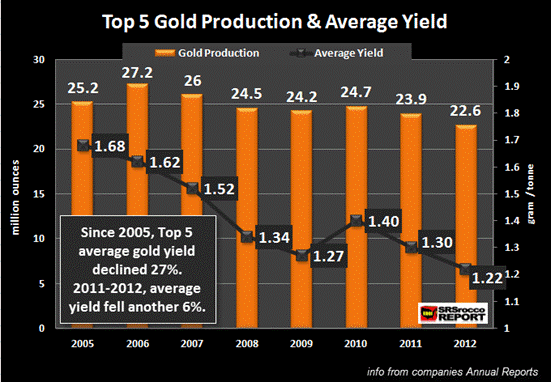
In 2005, the top five gold producers had an average yield of 1.68 g/t, but by 2012 this had fallen 27% to 1.22 g/t. The largest gold miners today are extracting gold at 20 times less the yield the world was producing in the late 1800's. As ore grades decline, it takes a great deal more energy to extract and process the same or less metal.
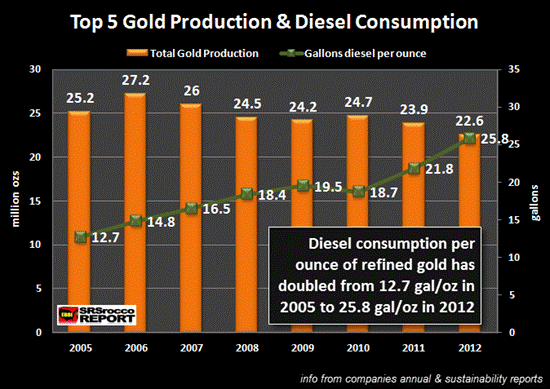
In 2005, the these miners produced 25.2 million ounces of gold and consumed 12.7 gallons of diesel per ounce. However, by 2012 total gold production declined to 23.9 million ounces while diesel consumption doubled to 25.8 gallons per ounce.
Not only has the actual energy cost increased substantially in the gold mining industry, so has everything else. Labor, plant, equipment and materials are also impacted by a greater degree due to higher oil prices.
You will notice that while the top 5 companies average yield only fell by 27%, diesel consumption per ounce of gold more than doubled. So, as ore grades continue to decline, energy consumption will increase exponentially in the future.
The Gold-Oil Ratio is the Key to Much Higher Gold Prices
In my previous article "The Precious Metal Investors Greatest Secret Weapon", I stated the following:
GOLD-OIL RATIO (Gold at $20.67 in 1932 & $35 in 1936)
1932 = 24 barrels of oil would equal an oz of gold
1936 = 32 barrels of oil would equal an oz of gold
2013 = 14 barrels of oil would equal an oz of gold
During the depths of the depression, an ounce of gold could buy 24 barrels of oil in 1932. After FDR revalued gold and as the U. S. economy recovered in 1936 (to a degree), it took 32 barrels of oil to equal an ounce of gold.
At the time of the writing of the article linked above (July), the gold-oil ratio was 14 to 1, using Brent Crude as a comparison, while the U.S. West Texas Crude was 12 to 1. The following figures will be comparing the price of gold to the U.S. West Texas Crude price.
This next chart shows the gold-oil ratio range in the past three years:
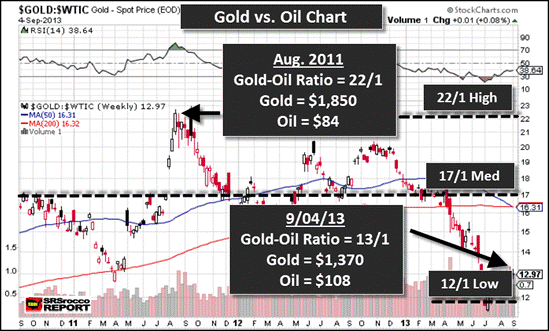
In Aug. of 2011 when the price of gold was $1.850 and a barrel of U.S. crude was $84, the gold-oil ratio was at a high of 22/1. Presently, the gold-oil ratio is 13/1 with a gold price of $1,370 with a barrel of oil at $108.
Many analysts believe that gold was extremely oversold in Aug-Sept of 2011 when it hit a new high of $1,900. However, we can see that the gold-oil ratio (22/1) did not surpass the 1932 level of 24/1 at a time when the price of a barrel of oil declined substantially as the U.S. economy was suffering a huge depression.
When gold hit its high in Aug-Sept 2011, the price of oil was only $84. Today, the price has risen $24 to $108. As I mentioned earlier in the article, the price of oil greatly impacts the gold mining industry. Furthermore, in the earlier part of the 1900's, the majority of gold came from underground mines where energy consumption was a much smaller percentage.
So, as the price of oil increases, it will ultimately push gold to new highs:
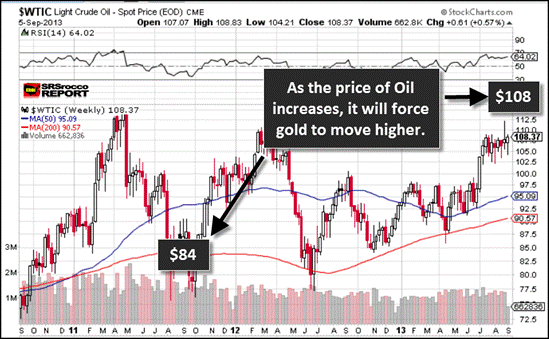
If we take the current price of U.S. West Texas Crude of $108 as well as higher levels and forecast how it would impact the price of gold at different gold-oil ratios, we can see just how undervalued the yellow metal has become.
The first table calculates what the price of gold would be at a 17 to 1 ratio to oil. This 17/1 ratio is the medium level shown in the first chart where the average gold-oil ratio falls:
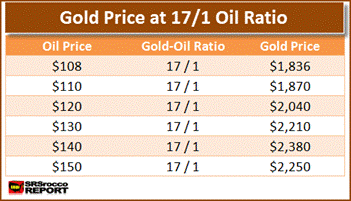
So, if the price of gold was valued at the average gold-oil ratio, the price would be $1,836 at the current oil price of $108. Moreover, if the oil price increased, we can see how it would impact the value of gold. Currently, the price of gold ($1,390) is nearly $450 less an ounce than it would be ($1,836) at its average 17/1 ratio to oil.
This huge difference in these two prices smells of market manipulation.
Now, if the gold-oil ratio climbed back to its previous high of 22/1, the price of gold would be substantially higher:
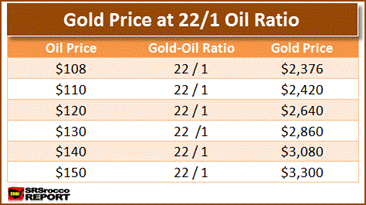
In Aug of 2011, the price of gold was $1,850, a barrel of oil was $84 and the gold-oil ratio was 22/1. If we apply the same 22/1 ratio to the present price of oil ($108), gold would now be $2,376... nearly $1,000 more than it is today.
Another issue that is not being addressed is the falling EROI - Energy Returned on Invested of energy. In the 1930's, the U.S. was producing oil & gas at an EROI of 100/1. Thus, with the cost of one barrel of oil, the industry could supply 100 barrels to the market. Today, the U.S. EROI of oil & gas is probably below 10/1. Shale oil is negatively impacting the U.S. energy EROI as its EROI is approximately 5/1.
This means, it takes a great deal more capital and energy to produce a barrel of oil today than it did in the early 1900's. Furthermore, there is less capital available to the market to invest in other aspects of the economy. Basically, the falling EROI of energy consumes an ever-increasing portion of the available investment capital in the market.
That is why a Falling EROI of oil will actually push the gold-oil ratio to higher levels. Why? Two reasons:
1) As the EROI of energy falls, it becomes more expensive to produce energy. As gold ore grades decline, it takes more energy to produce the same or less metal. Both of these factors will continue to push the cost of producing gold to much higher prices. Thus, increased costs mean higher prices to the public.
2) Because the typical assets that derive their value in a high EROI energy environment (in the past), will become increasingly worthless when the opposite takes place. For example, Real Estate values (residential, commercial & industrial) will fall as the price of energy increases while the supply decreases. If an economy has 10-20% less energy in the future... there will be a lot less demand for homes, strip-malls, and industrial warehouse space.
Taking into account all of these variables, I believe we are going to see the 32/1 gold-oil ratio that we had in 1936 after FDR revalued gold. This may take place by an official revaluation, or due to market forces dealing with much more expensive energy prices on top of falling supply.
This last table provides the gold investor with an idea of how a 32/1 ratio would impact gold at the following oil prices:
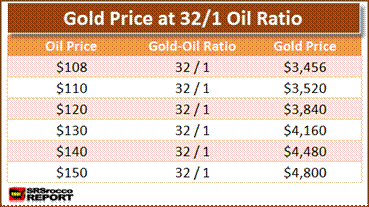
At the current oil price of $108, the price of gold would be $3,456 with a 32/1 gold-oil ratio. If the price of oil moved up to $120 a barrel, the price of gold would be $3,840 at the same ratio.
Even though world governments may attempt to revalue gold to back the huge amount of worthless currency and debts outstanding, this system will not last very long. There will not be the cheap and available energy supply in the future to generate positive economic growth to pay back these debts. This is why Gold and silver will become some of the best store of values and investments.
The 32 to 1 gold-oil ratio will turn out to be too conservative when the world switches out of increasingly worthless paper assets and into the precious metals. We have no idea of what the price or value an ounce of gold would be once the public tries to invest into a market that has an estimated 100/1 fractional reserve.
Lastly, very few investors realize how much energy factors into everything in the economy. Gold and silver's stored "Economic Energy" is derived from the EROI energy ratio. The falling EROI of energy is going to destroy a great deal of supposed wealth in the world. The best way to protect that wealth in the future will be in physical assets such as gold and silver.
At the SRSrocco Report, we will explore how energy will impact the mining industry in the future. Falling ore grades and decreasing yields are only part of the problem. As net oil exports continue to decline, energy prices will rise putting more pressure on the mining industry. Thus, rising energy costs will guarantee rising prices of gold and silver.
© 2013 Copyright Steve St .Angelo - All Rights Reserved Disclaimer: The above is a matter of opinion provided for general information purposes only and is not intended as investment advice. Information and analysis above are derived from sources and utilising methods believed to be reliable, but we cannot accept responsibility for any losses you may incur as a result of this analysis. Individuals should consult with their personal financial advisors.
© 2005-2022 http://www.MarketOracle.co.uk - The Market Oracle is a FREE Daily Financial Markets Analysis & Forecasting online publication.



